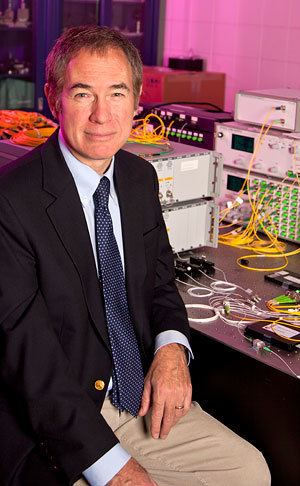Name Paul Prucnal | ||
 | ||
Known for Optical Code Division Multiple Access (OCDMA)Terahertz Optical Asymmetric Demultiplexer (TOAD) Notable awards Rudolf Kingslake Medal and Prize SPIEFellow of the IEEE (1992)Fellow of the Optical Society of America (1997) Fields Photonics, Electrical engineering | ||
Residence United States of America | ||
Paul R. Prucnal is a Professor of Electrical Engineering at Princeton University. He is best known for his seminal work in Neuromophic Photonics, optical code division multiple access (OCDMA) and the invention of the terahertz optical asymmetric demultiplexor (TOAD). He is currently a fellow of IEEE and the Optical Society of America.
Contents
Life and career
Prucnal received his A.B. In mathematics and physics from Bowdoin College in 1974, graduating summa cum laud, where he also studied piano with William Eves, a pupil of Robert Casadesus. He then earned M.S., M.Phil. and Ph. D. degrees in electrical engineering from Columbia University in 1976, 1978 and 1979, respectively, where he did his doctoral work with Malvin Carl Teich. After his doctorate, Prucnal joined the faculty at Columbia University in 1979. As a member of the Columbia Radiation Laboratory, he performed groundbreaking work in OCDMA and self-routed photonic switching. In 1988, he joined the faculty at Princeton University.
His developmental research on optical CDMA initiated a new research field in which more than 1000 papers have since been published, exploring applications ranging from information security to communication speed and bandwidth. In 1993, he invented the "Terahertz Optical Asymmetric Demultiplexer," the first optical switch capable of processing terabit per second (Tb/s) pulse trains. With support from DARPA in the 1990s, his group was the first to demonstrate an all-optical 100 gigabit/sec photonic packet switching node and optical multiprocessor interconnect.
Prucnal is editor of the book, Optical Code Division Multiple Access: Fundamentals and Applications. He was an Area Editor of IEEE Transactions on Communications. He has authored or co-authored more than 350 journal articles and book chapters and holds 28 U.S. patents. He is a fellow of both the Institute of Electrical and Electronics Engineers (IEEE) and the Optical Society of America (OSA), and a member of honor societies including Phi Beta Kappa and Sigma Xi. He was the recipient of the 1990 Rudolf Kingslake Medal for his paper entitled "Self-routing photonic switching with optically-processed control" and has won multiple teaching awards at Princeton.
He has been instrumental in founding the field of Neuromorphic Photonics and developing the "photonic neuron", a high speed optical computing device modeled on neural networks, as well as integrated optical circuits to improve wireless signal quality by cancelling radio interference.
He resides in Princeton with his wife Mindy and daughters Jenny and Katie.
